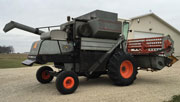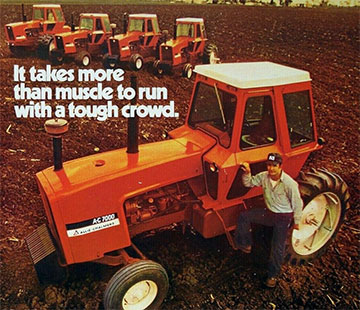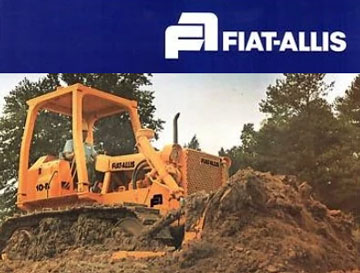|
Prior Page
Next Page
The Rising Power in Farming
|
|---|
| 1964 |
 Farm
tractors are getting bigger and better during the 60's. Allis-Chalmers kicks off
it's next series of tractors with the "One-Ninety" and the turbo-charged
"One-Ninety XT" while most of the "D" series is still in production. The
new tractors feature a console for lift and hydraulic controls plus an
elevated operator platform which greatly improves visibility and operator comfort. Farm
tractors are getting bigger and better during the 60's. Allis-Chalmers kicks off
it's next series of tractors with the "One-Ninety" and the turbo-charged
"One-Ninety XT" while most of the "D" series is still in production. The
new tractors feature a console for lift and hydraulic controls plus an
elevated operator platform which greatly improves visibility and operator comfort. |
| 1967 |
 The "One-Seventy" and "One-Eighty" are introduced to take the place of very successful D series tractors. Both share the new styling of the "One-Ninety" and are available with both gas and diesel engines. The diesel version of the "One-Seventy" utilizes a Perkins built engine. Both models are in production until 1974 and switch to numeric (170 and 180) decals in the latter half of the run. The "One-Seventy" and "One-Eighty" are introduced to take the place of very successful D series tractors. Both share the new styling of the "One-Ninety" and are available with both gas and diesel engines. The diesel version of the "One-Seventy" utilizes a Perkins built engine. Both models are in production until 1974 and switch to numeric (170 and 180) decals in the latter half of the run. |
| 1968 |
 Colt Firearms chairman David Scott is
brought in to turn the company around and defend against recent takeover
attempts. Scott gets to work by eliminating 8,000 mostly office jobs and
venturing into new markets. Nearly $250 million is spent to modernize some plants and shut down others.
Allis-Chalmers gets into the lawn and outdoor products business with products such as the Terra Tiger ATV, golf carts, chain saws, and dirt bikes.
By 1970, the company has returned to profitability. Colt Firearms chairman David Scott is
brought in to turn the company around and defend against recent takeover
attempts. Scott gets to work by eliminating 8,000 mostly office jobs and
venturing into new markets. Nearly $250 million is spent to modernize some plants and shut down others.
Allis-Chalmers gets into the lawn and outdoor products business with products such as the Terra Tiger ATV, golf carts, chain saws, and dirt bikes.
By 1970, the company has returned to profitability.

As farms continue to grow, so does the need for higher volume combines to harvest them. The model F and G combines are introduced to fill that need. Both models offer several improvements in addition to their size, most notably
diesel engines and Hydro-traction drive.
|
| 1970 |
 The "Hundred" series
reaches maturity with the addition of several new models. The Renault
built three cylinder "One-Sixty" on the lower end, the 175 and 185 in the
middle, and the "Two-Ten" and "Two-Twenty" on the upper end.
The 185 will prove to be a popular all-purpose tractor and remain in
production until 1981. The two largest new models are available with factory cabs and the "Two-Twenty"
offers optional front-wheel assist. The "Hundred" series
reaches maturity with the addition of several new models. The Renault
built three cylinder "One-Sixty" on the lower end, the 175 and 185 in the
middle, and the "Two-Ten" and "Two-Twenty" on the upper end.
The 185 will prove to be a popular all-purpose tractor and remain in
production until 1981. The two largest new models are available with factory cabs and the "Two-Twenty"
offers optional front-wheel assist.

Allis-Chalmers begins production of the world's largest crawler tractor, the massive HD-41.
Powered by a 524hp 12 cylinder diesel, this engineering achievement weighs over
50 tons and can be ordered with a 20ft blade. |
| 1971 |
The company name is changed from Allis-Chalmers Manufacturing Company to Allis-Chalmers Corporation.
This is meant to communicate a new direction and broader corporate vision. |
| 1972 |
The 200 is introduced to replace the
aging "One-Ninety XT". The 200 features an enhanced cooling system and
several other design improvements and will remain in the lineup into 1975. |
| 1973 |
 The
new 7000 series is introduced. The 7030 and 7050 have a number of new features
including a sleek new cab design and a 20-speed Power Director transmission.
The first two models are short-lived and are soon replaced by a range of models.
The Allis-Chalmers built 4WD models 7580 and 8550 eventually complete the
lineup. The
new 7000 series is introduced. The 7030 and 7050 have a number of new features
including a sleek new cab design and a 20-speed Power Director transmission.
The first two models are short-lived and are soon replaced by a range of models.
The Allis-Chalmers built 4WD models 7580 and 8550 eventually complete the
lineup. |
| 1974 |
 The troubled construction equipment division is merged
into Italy's FIAT SpA. CEO Scott signs a joint-venture agreement forming
the Fiat-Allis construction equipment company. Allis-Chalmers lacked the
equipment sales volume to perform the research, development, and marketing
required to effectively compete in the heavy construction equipment business
against competitors like Caterpillar and International Harvester.
Allis-Chalmers initially holds 35% of the stock in Fiat-Allis. The troubled construction equipment division is merged
into Italy's FIAT SpA. CEO Scott signs a joint-venture agreement forming
the Fiat-Allis construction equipment company. Allis-Chalmers lacked the
equipment sales volume to perform the research, development, and marketing
required to effectively compete in the heavy construction equipment business
against competitors like Caterpillar and International Harvester.
Allis-Chalmers initially holds 35% of the stock in Fiat-Allis. |
| 1977 |
The farm equipment market is booming with an ever-increasing appetite for more horsepower.
Farm equipment manufacturers are making huge profits, Allis-Chalmers included.
Annual profit climbs to $58.7 million for the year. |
| 1978 |
The company is struggling in the electrical distribution
business and enters a joint venture with Siemens to form Siemens-Allis. Allis-Chalmers
places all electrical distribution products into the venture. Siemens and
Allis will each hold 50% of the stock. |
| 1979 |
The end of the U.S. government's shale oil program is a
major disappointment to Allis-Chalmers. The company had spent
millions on research and development. |
|
Prior Page
Next Page
|
|---|

 Farm
tractors are getting bigger and better during the 60's. Allis-Chalmers kicks off
it's next series of tractors with the "One-Ninety" and the turbo-charged
"One-Ninety XT" while most of the "D" series is still in production. The
new tractors feature a console for lift and hydraulic controls plus an
elevated operator platform which greatly improves visibility and operator comfort.
Farm
tractors are getting bigger and better during the 60's. Allis-Chalmers kicks off
it's next series of tractors with the "One-Ninety" and the turbo-charged
"One-Ninety XT" while most of the "D" series is still in production. The
new tractors feature a console for lift and hydraulic controls plus an
elevated operator platform which greatly improves visibility and operator comfort. The "One-Seventy" and "One-Eighty" are introduced to take the place of very successful D series tractors. Both share the new styling of the "One-Ninety" and are available with both gas and diesel engines. The diesel version of the "One-Seventy" utilizes a Perkins built engine. Both models are in production until 1974 and switch to numeric (170 and 180) decals in the latter half of the run.
The "One-Seventy" and "One-Eighty" are introduced to take the place of very successful D series tractors. Both share the new styling of the "One-Ninety" and are available with both gas and diesel engines. The diesel version of the "One-Seventy" utilizes a Perkins built engine. Both models are in production until 1974 and switch to numeric (170 and 180) decals in the latter half of the run. Colt Firearms chairman David Scott is
brought in to turn the company around and defend against recent takeover
attempts. Scott gets to work by eliminating 8,000 mostly office jobs and
venturing into new markets. Nearly $250 million is spent to modernize some plants and shut down others.
Allis-Chalmers gets into the lawn and outdoor products business with products such as the Terra Tiger ATV, golf carts, chain saws, and dirt bikes.
By 1970, the company has returned to profitability.
Colt Firearms chairman David Scott is
brought in to turn the company around and defend against recent takeover
attempts. Scott gets to work by eliminating 8,000 mostly office jobs and
venturing into new markets. Nearly $250 million is spent to modernize some plants and shut down others.
Allis-Chalmers gets into the lawn and outdoor products business with products such as the Terra Tiger ATV, golf carts, chain saws, and dirt bikes.
By 1970, the company has returned to profitability.

 The "Hundred" series
reaches maturity with the addition of several new models. The Renault
built three cylinder "One-Sixty" on the lower end, the 175 and 185 in the
middle, and the "Two-Ten" and "Two-Twenty" on the upper end.
The 185 will prove to be a popular all-purpose tractor and remain in
production until 1981. The two largest new models are available with factory cabs and the "Two-Twenty"
offers optional front-wheel assist.
The "Hundred" series
reaches maturity with the addition of several new models. The Renault
built three cylinder "One-Sixty" on the lower end, the 175 and 185 in the
middle, and the "Two-Ten" and "Two-Twenty" on the upper end.
The 185 will prove to be a popular all-purpose tractor and remain in
production until 1981. The two largest new models are available with factory cabs and the "Two-Twenty"
offers optional front-wheel assist.

 The
new 7000 series is introduced. The 7030 and 7050 have a number of new features
including a sleek new cab design and a 20-speed Power Director transmission.
The first two models are short-lived and are soon replaced by a range of models.
The Allis-Chalmers built 4WD models 7580 and 8550 eventually complete the
lineup.
The
new 7000 series is introduced. The 7030 and 7050 have a number of new features
including a sleek new cab design and a 20-speed Power Director transmission.
The first two models are short-lived and are soon replaced by a range of models.
The Allis-Chalmers built 4WD models 7580 and 8550 eventually complete the
lineup. The troubled construction equipment division is merged
into Italy's FIAT SpA. CEO Scott signs a joint-venture agreement forming
the Fiat-Allis construction equipment company. Allis-Chalmers lacked the
equipment sales volume to perform the research, development, and marketing
required to effectively compete in the heavy construction equipment business
against competitors like Caterpillar and International Harvester.
Allis-Chalmers initially holds 35% of the stock in Fiat-Allis.
The troubled construction equipment division is merged
into Italy's FIAT SpA. CEO Scott signs a joint-venture agreement forming
the Fiat-Allis construction equipment company. Allis-Chalmers lacked the
equipment sales volume to perform the research, development, and marketing
required to effectively compete in the heavy construction equipment business
against competitors like Caterpillar and International Harvester.
Allis-Chalmers initially holds 35% of the stock in Fiat-Allis.